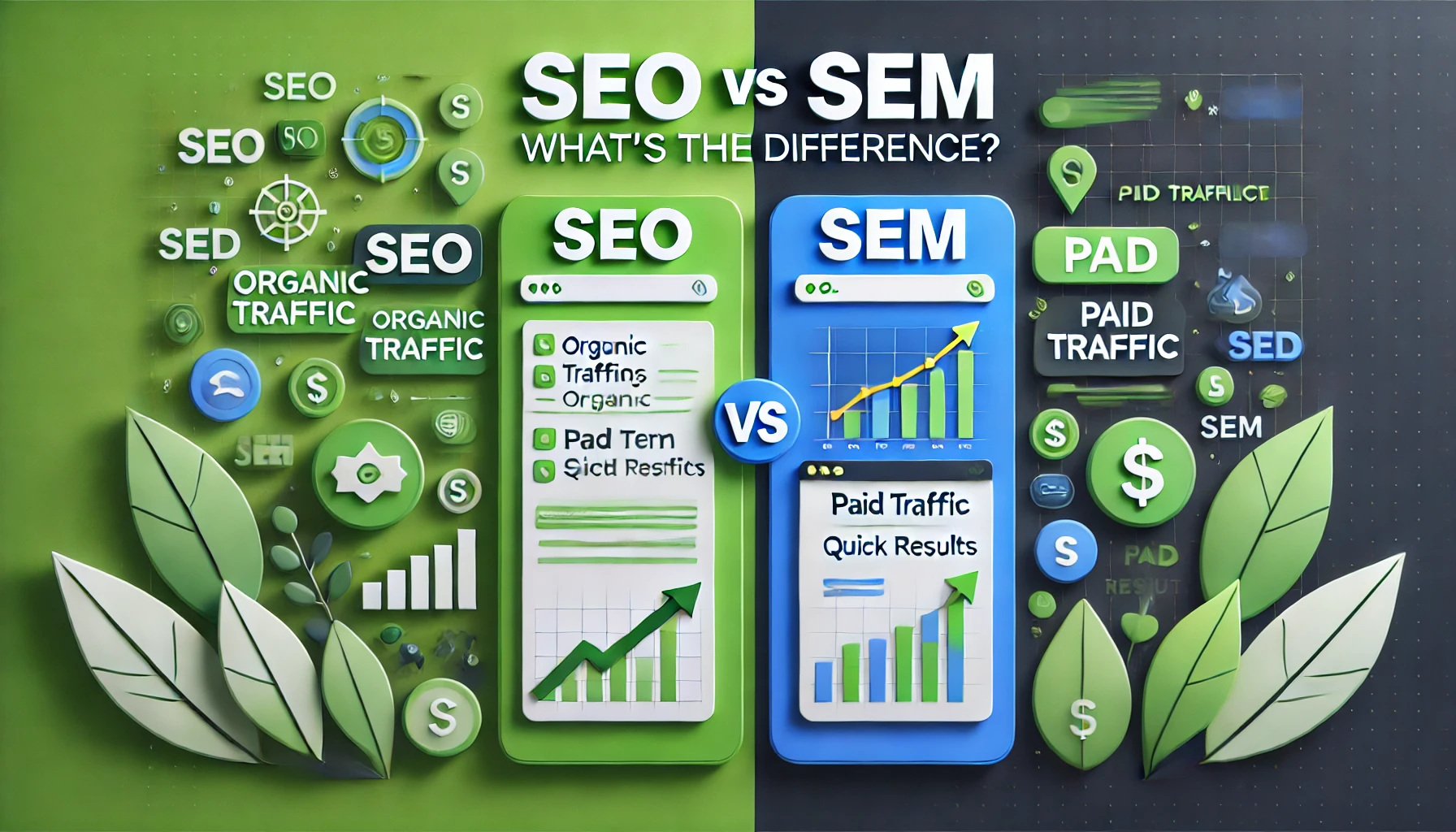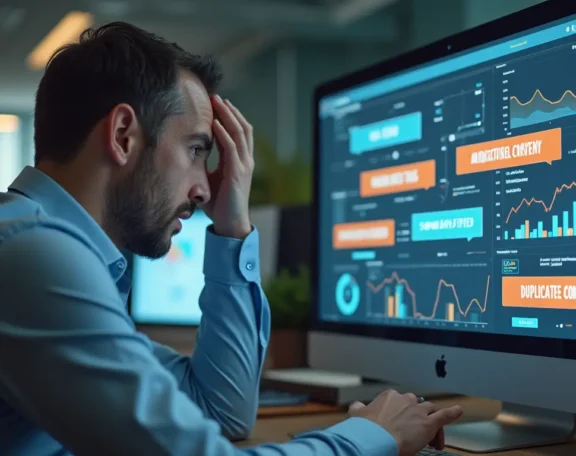Introduction
In today’s digital world, almost every business need an online presence to reach more customers. Two of the most popular ways to do that are SEO (Search Engine Optimization) and SEM (Search Engine Marketing). But what really is the difference between them? This blog post is here to explain SEO vs SEM in plain language.
Both SEO and SEM help your website get found by people using search engines, but they do it in different ways. While SEO focuses on improving your site organically, SEM is more about paid advertising. With the right mix of both, you can boost your site’s visibility and reach more potential customers.
Throughout this guide, we will use the phrase SEO vs SEM several times. This is not only for clarity but also to help search engines understand what this blog is about. So, whether you are a beginner or have some experience in digital marketing, this guide will help clear up the confusion.
What is SEO?
SEO stands for Search Engine Optimization. It is the process of optimizing your website to rank higher in the search engine results pages (SERPs) without paying for ads. SEO is all about making small changes to your website design and content that make your site more attractive to search engines like Google. also read about game changing seo trends for 2025
The Main Components of SEO
On-Page SEO:
- Content Quality: Write useful, engaging, and original content that answer your readers’ questions. When writing about SEO vs SEM, make sure your content is clear and covers all the basics.
- Keyword Usage: Naturally include your target keywords (like SEO vs SEM) in your headings, paragraphs, and meta tags. But dont overdo it – keep it natural!
- Title Tags & Meta Descriptions: These are the first things a user sees on the search results page. Make them catchy and informative.
Off-Page SEO:
- Backlinks: When other reputable websites link to your site, it tells search engines that your content is trustworthy.
- Social Signals: Shares, likes, and comments on social media can help boost your site’s authority.
Technical SEO:
- Site Speed: A fast-loading website makes users happy and helps in better rankings.
- Mobile-Friendliness: With most people browsing on mobile devices, your website must be responsive.
- Site Structure: A clear structure and proper navigation help both users and search engines find your content easily.
Why is SEO Important?
SEO is a long-term investment. When you work on your SEO, you are building a foundation that can bring continuous organic traffic to your website. The traffic from SEO is “free” in the sense that you dont pay for each click like you do with ads. However, SEO does require time, effort, and sometimes a bit of money for tools or professional help.
Even if you make a few grammar mistakes or your style seems a bit casual, the main thing is that your content is helpful and accessible. This is why many people appreciate content written in a natural tone that sounds human and relatable.
What is SEM?
SEM stands for Search Engine Marketing. Unlike SEO, which focuses on organic search results, SEM involves paid strategies to get your website noticed. SEM is all about using paid ads, such as Google Ads, to get your website to the top of the search results pages.
How SEM Works
Paid Advertising:
With SEM, you pay to have your ads shown when someone searches for a keyword that you choose. For example, if you bid on the term “SEO vs SEM”, your ad might appear at the top of the search results.Cost Per Click (CPC):
Most SEM campaigns use a CPC model. This means you only pay when someone clicks on your ad.Ad Auction:
Google and other search engines run auctions to determine which ads get shown. They look at your bid, the quality of your ad, and its relevance to the search query.Ad Formats:
SEM isn’t limited to text ads. You can also use display ads, video ads, and more to reach your audience.
Benefits of SEM
Immediate Results:
One of the biggest advantages of SEM is that you can see results quickly. As soon as you start your campaign, your ads will appear, and you can start getting traffic.Precise Targeting:
SEM allows you to target your audience based on various factors like location, language, and device. This means you can reach exactly the people who are most likely to be interested in your products or services.Measurable Performance:
With tools like Google Analytics, you can track the performance of your SEM campaigns in real time. This makes it easy to adjust your strategy and improve your return on investment.Control Over Your Budget:
You set your own budget and bid amounts, giving you full control over how much you want to spend on your ads.
Drawbacks of SEM
Cost:
Since SEM is a paid model, costs can add up quickly, especially in competitive markets. Once you stop paying, your traffic stops instantly.Dependence on Budget:
Your results are directly tied to your spending. If you dont have enough budget, your ads might not get enough exposure.Short-Term Focus:
While SEM can bring in immediate traffic, it does not build long-term authority the way SEO can.
SEO vs SEM: Key Differences
Now that we have clear definitions for both SEO and SEM, let’s dive into the main differences between them. This section will help you understand the SEO vs SEM debate and decide which strategy is best for your business.
1. Cost Structure
SEO:
The main cost in SEO is the time and effort required to optimize your website. While you might spend money on tools or consultants, you are not paying per click. This makes SEO a cost-effective strategy in the long run.SEM:
With SEM, you are paying for every click on your ad. This can get expensive if your campaign is not well optimized. SEM is like paying rent for immediate visibility, but if you stop paying, the visibility disappears.
2. Timeline for Results
SEO:
SEO is a slow cooker. It takes time – sometimes months – to see noticeable improvements in your search rankings. However, once your site starts ranking, the traffic tends to be steady and long-lasting.SEM:
SEM offers fast results. As soon as your ad campaign goes live, you can start getting clicks and visits. This makes SEM a great choice for short-term campaigns or when you need a quick boost.
3. Sustainability
SEO:
SEO builds long-term value. If you continuously optimize your website, you can maintain a high ranking even if you reduce your SEO efforts later. Organic traffic tends to be more sustainable over time.SEM:
SEM is not as sustainable as SEO. If you stop funding your ads, the traffic stops immediately. This means SEM is best for situations where you need immediate results rather than long-term growth.
4. Trust and Credibility
SEO:
Organic search results are often viewed as more trustworthy by users. People tend to trust websites that rank naturally higher because they believe these sites are more relevant and authoritative.SEM:
While SEM ads are effective, many users tend to skip over them because they are clearly marked as ads. However, a well-crafted SEM campaign can still build trust if the ad copy is strong and relevant.
5. Measurability and Control
SEO:
SEO results can be tracked using various analytics tools, but it may not always be clear what is driving the changes in your rankings. SEO is more about long-term trends and improvements.SEM:
SEM is highly measurable. Every click, impression, and conversion can be tracked in real time. This makes it easier to adjust your campaigns on the fly for better results.
6. Flexibility and Experimentation
SEO:
Changing your SEO strategy takes time. If you update your content or change your keywords, it might be weeks before you see the impact. SEO is more of a long-term game.SEM:
SEM campaigns can be adjusted quickly. You can change your ad copy, bid amounts, or targeting criteria almost instantly, which allows for more experimentation and faster results.
In short, when you compare SEO vs SEM, you are really comparing a long-term, sustainable strategy (SEO) with a fast, flexible, but potentially costly method (SEM). Both have their own place in a well-rounded digital marketing strategy.
When to Use SEO vs SEM
Knowing the differences between SEO and SEM is great, but how do you decide which one to use? Here are some guidelines to help you decide based on your business needs and goals.
Use SEO When:
You have a long-term strategy:
SEO is best when you want to build lasting organic traffic over time. If you can invest time and resources into creating quality content and optimizing your site, SEO is a solid bet.Budget is a concern:
If you dont have a big budget for paid ads, SEO is the way to go. Even though SEO takes time to deliver results, the ongoing cost is relatively low compared to SEM.Building trust and authority matters:
Organic rankings tend to build more trust among users. If you want your website to be seen as an authority in your niche, focusing on SEO is a great choice.
Use SEM When:
You need immediate results:
If you are launching a new product, running a seasonal promotion, or need quick traffic for an event, SEM can give you fast results.You want to target specific demographics:
SEM allows you to set precise parameters for who sees your ads. This is especially useful if you have a clear target audience.You want to experiment and adjust quickly:
Because SEM campaigns can be changed rapidly, it’s a good choice if you want to test different messages or target groups and see immediate feedback.
Combining SEO and SEM for Maximum Impact
Many successful businesses use a combination of both SEO and SEM to achieve the best results. Instead of choosing one over the other, integrating them can give you a balanced digital marketing strategy.
Benefits of Combining Both
Immediate and Long-Term Results:
SEM gives you that quick traffic boost while SEO works behind the scenes to build a steady stream of organic traffic. Over time, your SEO efforts can reduce your reliance on paid ads.Data-Driven Decisions:
The performance data from your SEM campaigns can help you identify which keywords and strategies work best. You can then apply these insights to your SEO strategy, creating a feedback loop that benefits both areas.Increased Brand Visibility:
When your website appears both as an ad and in organic search results, it increases your brand’s credibility and visibility. This dual presence can help in building trust among potential customers.Flexibility in Budget Allocation:
You can adjust your spending between SEO and SEM based on the results you see. For example, during a major product launch, you might invest more in SEM for immediate traffic, and then focus on SEO to sustain the growth.
How to Create an Integrated Strategy
Keyword Research:
Use keyword research tools to find terms that perform well in both SEO and SEM. Make sure your primary focus keyword, such as SEO vs SEM, appears naturally in your content and ad campaigns.Content Creation:
Develop high-quality content that is optimized for SEO. This same content can also be used in your SEM landing pages. Repurposing content can save time and ensure consistency.Tracking and Analytics:
Use tools like Google Analytics and Google Ads reporting to monitor your campaigns. Look for trends in which keywords drive the most traffic and conversions, then tweak both your SEO and SEM strategies accordingly.Testing and Iteration:
Don’t be afraid to experiment. Adjust your ad copy, test different landing pages, and continually refine your SEO practices. The digital marketing landscape is always changing, so stay flexible.
Real-World Examples and Case Studies
Let’s look at a couple of examples to show how understanding SEO vs SEM can make a real difference in a business’s online performance.
Example 1: A Local Retail Store
Imagine a local clothing store that has been open for a few years. The owner wants more people in the community to know about the store. Here’s how they could use both strategies:
SEO Approach:
The store creates a blog on its website with articles like “Best Fashion Trends in [City]” and “How to Style Your Outfit for Local Events.” They also optimize their website for local search terms like “clothing store in [City].” Over time, the blog helps build organic traffic and establishes the store as a local authority in fashion.SEM Approach:
During a seasonal sale, the store runs a Google Ads campaign targeting keywords such as “discount clothing in [City]” and “sale on clothes.” This campaign brings immediate traffic, leading to a spike in in-store visits and online orders during the promotion.Result:
The combination of SEO for long-term growth and SEM for short-term boosts helps the store achieve a steady flow of customers, both online and offline.
Example 2: An Online Education Platform
An online education platform that offers digital marketing courses wants to expand its reach globally.
SEO Approach:
They publish detailed guides, tutorials, and case studies about topics like SEO vs SEM. Their high-quality content attracts organic traffic over time, and they gain authority as a go-to resource for learning digital marketing.SEM Approach:
When launching a new course, they use SEM to run targeted ad campaigns on search engines. By bidding on relevant keywords, they reach potential students who are actively looking for digital marketing education. This results in quick enrollment numbers for the course launch.Result:
The education platform enjoys both immediate course sign-ups from SEM and a growing base of organic traffic through their SEO efforts. This dual strategy helps them build a robust online presence.
Tips for Getting Started with SEO and SEM
Whether you are new to digital marketing or have been trying to juggle both SEO and SEM, here are some practical tips to help you get started.
Tips for Starting with SEO
Begin with Keyword Research:
Find keywords that are relevant to your business. Use tools like Google Keyword Planner or Ubersuggest. Focus on keywords like SEO vs SEM to attract the right audience.Create Quality Content:
Write articles, blogs, and guides that are useful and easy to read. Don’t worry too much about making everything perfect. A few grammar mistakes can make your writing feel natural and genuine.Optimize Your Website:
Make sure your site loads fast, is mobile-friendly, and has a clean structure. Use headings, subheadings, and bullet lists to make the content easy to scan.Build Backlinks:
Reach out to other websites, guest post on blogs, and be active on social media. Backlinks from reputable sites will help your site’s authority.Monitor Your Progress:
Use analytics tools to see how your site is performing. Look at your traffic sources and see what keywords are driving visits.
Tips for Starting with SEM
Set a Realistic Budget:
Determine how much you can spend daily or monthly. Remember, with SEM you pay per click, so budgeting is very important.Create Targeted Campaigns:
Choose specific keywords and design your ads to target the right audience. Use your research on SEO vs SEM to pick keywords that work well.Write Clear and Concise Ads:
Make sure your ad copy is easy to understand and has a strong call-to-action. Even if your grammar is a bit off sometimes, keep the message clear.Test Different Variations:
Run A/B tests on your ad copy and landing pages to see what gets the best results. Keep track of the metrics and adjust your campaigns accordingly.Track Everything:
Use Google Ads’ reporting tools to monitor the performance of your campaigns. Look at metrics like click-through rate (CTR), conversion rate, and cost per conversion.
Conclusion
So, what is the real difference between SEO vs SEM? In a nutshell, SEO is about building long-term organic traffic by optimizing your website and creating high-quality content, while SEM is about using paid advertising to get quick, measurable results. Each strategy has its own advantages and drawbacks:
- SEO is great for sustainable growth and building trust, but it takes time and effort to see significant results.
- SEM provides fast results and precise targeting, but it can be costly if you dont manage your budget carefully.
For many businesses, the best approach is to use both strategies in tandem. Use SEM for immediate visibility and quick wins, and invest in SEO for long-term success and credibility. Remember, there is no one-size-fits-all answer when it comes to digital marketing. It all depends on your business goals, budget, and timeline.
Even if your writing style isn’t perfect and you make a few grammar mistakes, what matters most is that your content is clear and valuable to your audience. Digital marketing is a marathon, not a sprint, and learning the difference between SEO vs SEM is an important step in building a successful online presence.
Frequently Asked Questions (FAQs)
1. What does SEO stand for and how does it work?
SEO stands for Search Engine Optimization. It involves optimizing your website’s content, structure, and technical elements to rank higher in organic search results. This brings in free, sustainable traffic over time.
2. What does SEM stand for and how is it different from SEO?
SEM stands for Search Engine Marketing and includes paid advertising methods like Google Ads. Unlike SEO, which focuses on organic traffic, SEM involves paying for your ads to appear at the top of search results. This difference is a key point in the SEO vs SEM discussion.
3. Can I use both SEO and SEM together?
Yes, many businesses use a combination of both strategies. While SEM gives you quick results, SEO builds long-term credibility and organic traffic. Using them together can help you achieve both immediate and sustained growth.
4. Which strategy is better for a small business with a limited budget?
If you have a limited budget, starting with SEO might be more cost-effective because it doesn’t require continuous spending per click. However, using targeted SEM campaigns for promotions can also help get immediate traffic when needed.
5. How long does it take to see results from SEO compared to SEM?
SEO can take several months to show significant results, as it relies on gradual improvements and organic growth. SEM, on the other hand, can deliver traffic almost instantly as soon as your ad campaigns are live.
Final Thoughts
Understanding the difference between SEO vs SEM is crucial for anyone looking to improve their digital marketing strategy. Whether you are a small business owner or a marketing professional, knowing when and how to use each strategy can make a big difference in your online success. Remember, it’s not about choosing one over the other – it’s about finding the right balance to meet your specific needs.
As you start your journey in digital marketing, keep experimenting and learning. The world of SEO and SEM is constantly changing, so staying updated and flexible is key. Even if your grammar isn’t perfect or your writing seems a bit off, the most important thing is that you communicate your message in a clear and genuine way.






